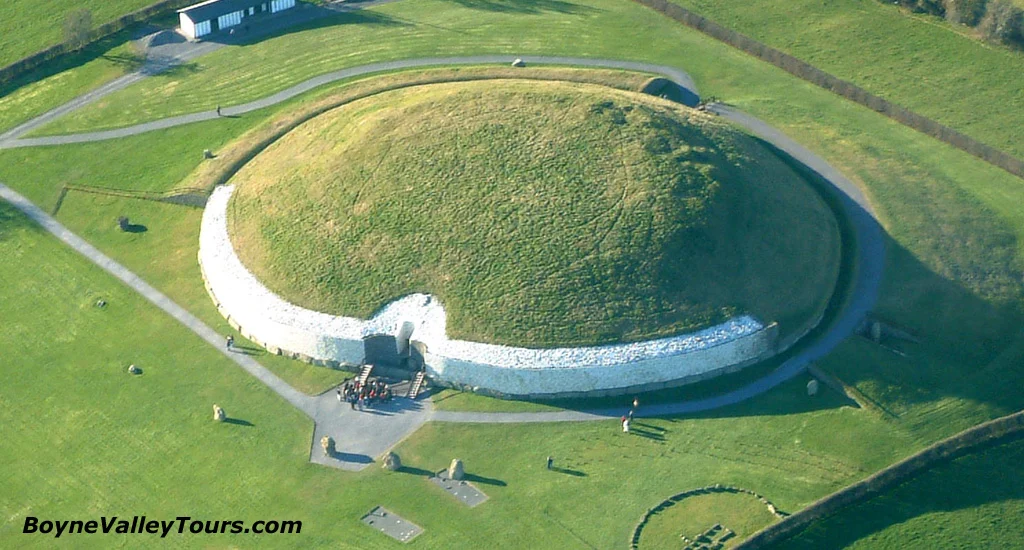 Book a tour
Book a tour
Newgrange – dating back to 3200 BC
In the heart of the Boyne Valley lies one of the world’s most remarkable prehistoric monuments, Newgrange. This enigmatic structure, older than the Great Pyramids and Stonehenge, has captivated the imagination of historians, archaeologists, and curious minds for centuries. But it wasn’t until 1699 that Newgrange was rediscovered, ushering in a new era of fascination with Ireland’s ancient past.
Newgrange, a remarkable structure dating back to around 3200 BC (over 5,200 years ago), stands as a testament to the profound significance it held for its builders during the Neolithic period. While modern archaeologists categorize it as a passage tomb, it is important to recognize that to those who constructed Newgrange, it likely embodied a multifaceted purpose. For them, it served not only as a tomb but likely also as a place of astrological, spiritual, religious, and ceremonial importance.
In the span of approximately 1,000 years, Newgrange experienced abandonment and gradually slipped into obscurity, succumbing to overgrowth and the loss of its original purpose. However, in the realm of later Celtic mythology, intriguing tales emerged. According to these mythological narratives, it was believed that the Tuatha Dé Danann, a mystical people, constructed Newgrange as a hallowed resting place for their revered leader, Dagda Mór. Furthermore, in the rich tapestry of Celtic mythology, Newgrange was also attributed as the sacred location where the great hero Cúchulainn was conceived, weaving an additional layer of mystique into the site’s enduring legacy.
Prior to the rediscovery of the passage and chamber in 1699, the mound was known as “Síd in Broga,” a term linked to the realm of fairy mounds in Irish folklore.
In 1699, it was the new landowner Charles Campbell who unwittingly stumbled upon Newgrange. He had purchased the land that included Newgrange, not knowing the historical treasure that lay hidden beneath the earth. While conducting excavation work on the property, laborers under Campbell’s employ discovered a long, low mound made of earth and stones. Little did they know that this seemingly ordinary mound held the secrets of Ireland’s distant past.
The workers began to dig, and as they uncovered more of the mound, they unearthed the entrance to a passage that led into the heart of the structure. Inside, they found an astonishing chamber, adorned with intricate carvings and mysterious symbols. This chamber was constructed with massive stones, and the ceiling was meticulously corbelled. As they ventured deeper into the passageway, they realized they had stumbled upon something extraordinary.
During the 18th century, Newgrange experienced a revival of interest as it was documented by numerous antiquarians and scholars. This rekindled attention gradually elevated its status, leading to its recognition as a venerable and significant ancient monument.
Professor Michael J. O’Kelly excavated and restored Newgrange during summer time excavations from 1962 to 1975. He discovered that the builders of Newgrange deliberately oriented the passage so that each year around the time of the winter solstice, the rays of the rising sun would shine through a special aperture he called a roofbox to illuminate the chamber.
In 1993, a pivotal moment in Newgrange’s history occurred as it earned the prestigious status of a UNESCO World Heritage Site, alongside its neighboring passage tombs. This remarkable designation underscored its profound global importance and solidified its long-term safeguarding.
Newgrange Video – Recorder 1962
A team of archaeologists lead by Professor Michael J O’Kelly from University College Cork have made fresh findings at Newgrange in County Meath. Discovered in 1699 the megalithic passage-tomb of Newgrange, is considered to be one of the best decorated tombs of its type in Western Europe. Along with nearby Knowth and Dowth, Newgrange forms a complex of archaeological sites at Brú na Bóinne in County Meath.
Prior to repair work being undertaken at Newgrange, Professor O’Kelly from University College Cork UCC and his team are excavating the site, to ensure the archaeological value of the tomb itself will not be damaged. The monument needs some repairs, so it was thought that the time had come when we should do some investigation around the edge of the mound before these repairs are undertaken. Professor O’Kelly’s team consists of three students from Uppsala University in Sweden, two students from Harvard University and Helen Kelly and Elizabeth Murphy from UCC. They work alongside two local labourers.
Folklore says the High Kings of Tara were buried at Newgrange, but Professor O’Kelly dismisses this as Newgrange dates 2000 years before Tara became an important historical monument. He postulates that chieftains were buried inside, remaining untouched until the tomb was plundered in the ninth century by the Vikings. Some of the new findings uncovered by Professor O’Kelly’s team include decorated kerbstones with chevron ornamentation and an intriguing mound of turf, which may be part of the passage grave itself or part of a preexisting structure made before the great cairn was thrown up.
The question to be solved now is, whether this turf mound is the same or an earlier time than the tomb or whether it belongs to an earlier time. The answer to this could provide a very valuable contribution to archaeology.
Ninety-year-old Anne Hickey, caretaker of Newgrange mound for sixty years describes the customs and local superstitions held about the mound. She says old people think fairies live there and they are terrified of them. There is also a white lady connected with the mound. This woman vanished when Anne Hickey approached her, mistaking her for a friend. I was very vexed that she disappeared so quick without me getting a chat with her.
This episode of ‘Newsview’ was broadcast on 14 August 1962. The reporter is Sean Egan.
Vale of the Boyne and Royal Meath published in 1898
The Newgrange mound is 70 feet high and covers an area of about two acres. It is chiefly composed of small stones and earth, weighing, as has been estimated, 180,000 tons. Originally it was surrounded by a circle of huge pieces of rock, but only 10 of these now remain. The sepulchral tumulus of Newgrange is one of the most remarkable monuments of human skill and labor to be found in the world. It has long excited the interest and admiration of antiquaries of almost every civilized nation. It is probably of greater antiquity than the Pyramids of Egypt and well nigh approaches them in grandeur.
The chamber is approached by a passage running nearly north and south, 63 feet long, three feet wide, and at the entrance three and a half feet high, rising to six feet, where the central chamber is reached. The tourist will have to move forward some distance on his hands and knees to reach the great sepulchral chamber, but the guide will lead the way with a light, and little difficulty will be experienced in accomplishing the task. The chamber, which is cruciform, is 25 feet high in the center. It has three recesses, one opposite the entrance, one facing west, and one east.
These are seven to nine feet in height, width, and depth. The walls consist of enormous stones placed upright with slabs horizontally placed across their tops. The stones are so arranged that each layer projects further towards the center than the one below, till one stone is sufficient to close the roof. Many of the stones show most elaborate carvings, supposed by some antiquarians to be symbolical. They consist of lozenges, spirals, concentric circles, chevrons, and cup markings in profuse variety. Within the niches of the great central chamber are several large saucer-shaped blocks of stone, supposed to be rude sarcophagi. Some of the stones forming the chamber appear to be water worn, and it is thought have been brought originally from the bed of the Boyne.
The Mounds at both Dowth and Newgrange are supposed to be the sepulchral chambers of Irish potentates who lived centuries before the Christian era. Owing to the discovery of iron knives here it is believed that they were plundered by the Danes about the ninth century. From the tops of both Mounds can be had one of the finest views of beautiful landscape in Ireland. Beneath the eyes of the tourist lies the richest portion of the plains of Meath, and in the distance can be seen the Carlingford Hills and a long range of the Mourne Mountains stretching into the sea.
John L. Stoddard’s Lectures published in 1901
Newgrange, easily reached from Dublin in a day, proved a most weird and interesting place. Leaving the jaunting-car which had brought me from the railway station a few miles away, I found myself confronted by what seemed to be merely an ordinary hill about seventy feet in height, covered with bushes, grass and trees. In reality, however, like the Pyramid of Cholula in Mexico, it is almost entirely artificial, and its green mantle covers an enormous cairn of stones, occupying nearly two acres, and estimated as weighing one hundred and eighty thousand tons.
Formerly a circle of thirty monster stones surrounded it, but all save twelve have disappeared. On reaching the entrance of this tumulus, I noticed that the huge stone threshold was carved with spirals, coils, and diamond-shaped figures in regular designs, which seemed like reproductions, on a gigantic scale, of the ornamentation wrought in gold filigree on some of the specimens of Celtic art preserved in the Dublin National Museum.
A narrow passage, sixty feet in length and lined with enormous blocks of stone, enabled me to go, without much difficulty, to what I found by lamplight to be a rotunda, whose dome-shaped roof, about twenty feet in height, was built by means of slabs which overlap one another toward the center, like a flight of steps.
What most surprised me here were the mysterious carvings which the lamplight showed on every portion of the walls from floor to ceiling. Why were they wrought here with such care, when it was known they would remain in total darkness, without an eye to note their beauty or significance? The hieroglyphics in the secret halls and apartments of Egyptian temples, such as Denderah and Edfou, though never greeted by the light of day, were seen at least by priests as they passed through those corridors with lamps; but this old Celtic tomb was closed designedly forever; and, like the Pyramids, would probably never have been disturbed but for the sacrilegious greed of man.
Did the devoted labor of those mound-builders spring from affection for the king who was to be buried here? Or did they hope that he would recompense them from the spirit world? The royal tombs of Egypt are immeasurably grander, and display decorations worthy of the art and civilization of the Pharaohs; but they resemble Celtic burial-mounds in this, that the motive for their construction was the same, – the old, old longing to rest undisturbed.
Among the mighty ones of earth, in view of death, the dread of desecration has at times proved greater than the fear of being forgotten, and has caused their graves to be made both as secret and as strong as possible. It is, however, pathetic to recall how seldom this desire has been realized. “The Scipios’ tombs contain no ashes now.”
Where is the body, where even the superb sarcophagus, of Alexander the Great? Whither did Father Tiber bear the ashes of the Roman emperors, flung by the Goths from the imposing Mausoleum of Hadrian? Even the Pyramids, the oldest, mightiest and most-enduring structures ever reared by man, could not retain within their chambers, hidden with such skill, the bodies of their royal builders.
So, in this Celtic cairn, plundered by Danes eleven hundred years ago, no trace remains of him who was in all probability buried here with pomp and pageantry, characteristic of the Irish kings. Whether, indeed, it was the tomb of one king, or of many, who can tell? From its shrouded solitude there comes to us no whisper, even of a name.
The Valley of the Boyne – The Charm of Ireland 1914
We set off again, and the car climbed up and up to the summit of the ridge which overlooks the river; and presently we were rolling along a narrow road bordered with lofty elms, and then, in a broad pasture to our right, we saw another mound, far larger than the first, and knew that it was Newgrange.
Four mighty stones stand like sentinels before it. The largest of them is eight or nine feet high above the ground and at least twenty in girth; and they are all that are left of a ring of thirty-five similar monsters which once guarded the great cairn with a circle a quarter of a mile around. Like the tumulus of Dowth, this of Newgrange is girdled by a ring of great stone blocks, averaging eight or ten feet in length, and laid closely end to end ; and on top of them is a wall of un cemented stones three or four feet high. Behind the wall rises the cairn, overgrown with grass and bushes and even trees; but below the skin of earth is the pile of stones, heaped above the chambers of the dead.
The entrance here is a few feet above the level of the ground, and is the true original entrance, which the one at Dowth is not, for the level of the ground there has risen. This little door consists of two upright slabs and a transverse one. Below it is placed a great stone, covered with a rich design of that spiral ornamentation peculiar to the ancient Irish emblematic, it is said, of eternity, without beginning and without end. The stone above the door is also carved, and my photograph, opposite this page, gives a very fair idea of how the entrance looks.
We found a woman waiting for us she had heard the rattle of our wheels far down the road, and had hastened from her house nearby to earn sixpence by providing us with candles; and she led the way through the entrance into the passage beyond. As at Dowth, it is formed of huge slabs inclined against each other.
But here they have given way under the great weight heaped upon them, and the passage grew lower and lower, until the woman in front of us was crawling on her hands and knees. The clergyman, who was behind her, examined the low passage by the light of his candle, and then said he didn’t think he’d try it.
“Oh, come along, sir,” urged the woman’s voice. ” ‘Tis only a few yards, and then you can stand again. If you was a heavy man, now, I wouldn’t be advisin’ it; I’ve seen more than one who had to be pulled out by his feet; but for a slim man the likes of you sure it is nothing.”
He still held back, so I squeezed past him, and went down on hands and knees, and crawled slowly forward in three-legged fashion holding my candle in one hand,, over the strip of carpet which had been laid on the stones to protect the clothing of visitors. As our guide had said, the passage soon opened up so that it was possible to stand upright again. I called back encouragement to my companion, and he finally crawled through too ; and then, as I held my candle aloft, I saw: that we had come out into a great vaulted chamber at least twenty feet high. Here, as at Dowth, the sides are formed of mammoth slabs, and the vault of other slabs laid one upon the other, each row projecting beyond the row below until the center is reached. Here too there are three recesses; but everything is on a grander scale than at Dowth, and the ornamentation is much more elaborate. It consists of intricate and beautifully formed spirals, coils, lozenges and chevrons; and here, also, the vandal had been at work, scratching his initials, sometimes even his detested name, upon these sacred stones. There was one especially glaring set of initials right opposite the entrance, deeply and evidently freshly cut, and I asked the woman how such a thing could happen.
“Ah, sir,” she said, “that was done by a young man who you would never think would be doing such a thing. He come here one day, not long since, and with him was a young woman, and they were very quiet and nice-appearing, so after I had brought them in, I left them to their selves, for I had me work to do ; but when I came in later, with another party, that was what I saw. And I made the vow then that never again would I be leaving any one alone here, no matter how respectable they might look.”
We commended her wisdom, and turned back to an inspection of the carvings. It was noticeable that there was no attempt at any general scheme of decoration, for the spirals and coils were scattered here and there without any reference to each other, some of them in inaccessible corners which proved they had been made before the stones were placed in position. Evidently they had been carved wherever the whim of the sculptor suggested; and so, in spite of their delicacy and beauty, they are in a way supremely childish.
But there is nothing childish about the tomb itself. Nobody knows from what forgotten quarry these great slabs were cut. Wherever it was, they had to be lifted out and dragged to the top of this hill and set in position and many of them weigh more than a hundred tons. The passage from the central chamber to the edge of the mound is sixty-two feet long; the mound itself is eight hundred feet around and fifty high, and someone has estimated that the stones which compose it weigh more than a hundred thousand tons.
For whom was it built? Perhaps for Conn, the Hundred Fighter, for tradition records that he was buried here, and he was worthy of such a tomb. If it was for Conn and of course that is only a guess it dates from about 200 A. D., for tradition has it that it was in 212 that Conn was treacherously slain at Tara, while preparing for the great festival of the Druids. Conn’s son, Art, was the last of the Pagan kings to be buried in the Druid fashion, for Art’s great son, Cormac, who came to the throne in 254, chose another sepulcher. He seems to have got some inkling of Christianity, perhaps from traders from other lands who visited his court. At any rate, he turned away from the Druids, and they put a curse upon him and caused a devil to attack him while at table, so that the bone of a salmon stuck in his throat and he died. But with his last breath he forbade his followers to bury him at Brugh-na-Boinne, in the tumulus with Conn and the rest, because that was a grave of idolaters ; he worshipped another God who had come out of the East; and he commanded them to bury him on the hill called Rosnaree, with his face to the sunrise. They disregarded his command, and tried to carry his body across the Boyne to the tumulus; but the water rose and snatched the body from them, and carried it to Rosnaree; and so there it was buried. From Newgrange, one can see the slope of Rosnaree, just across the river; but there is nothing to mark the grave of the greatest of the early kings of Erin.
Round Cormac spring renews her buds ;
In march perpetual by his side,
Down come the earth-fresh April floods,
And up the sea-fresh salmon glide.
And life and time rejoicing run
From age to age their wonted way;
But still he waits the risen Sun,
For still ’tis only dawning Day.
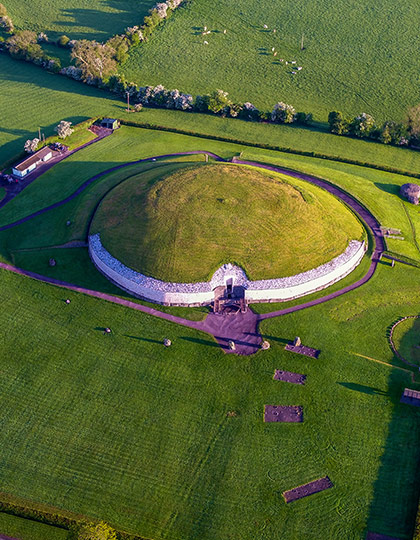
Newgrange & Boyne Valley

8hrs | €650 + Booking Fees

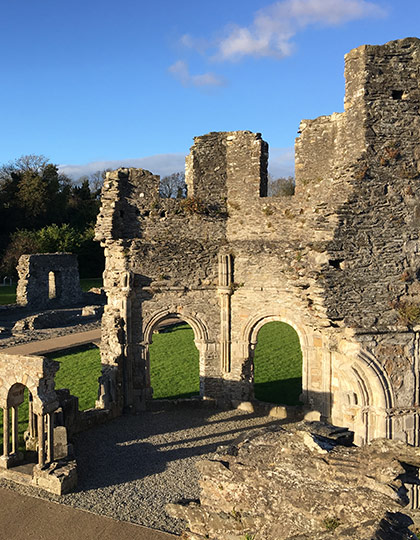
Boyne Valley Castles & Abbeys

8hrs | €650 + Booking Fees

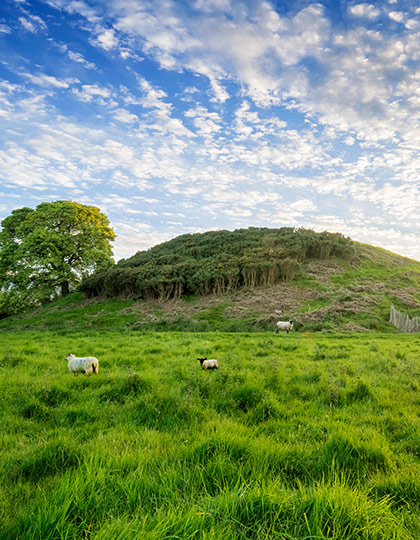
Meath Megalithic Sites

8hrs | €650 + Booking Fees


Glendalough & Scenic Wicklow

8hrs | €650 + Booking Fees


Wicklow Gardens & Scenery

8hrs | €650 + Booking Fees

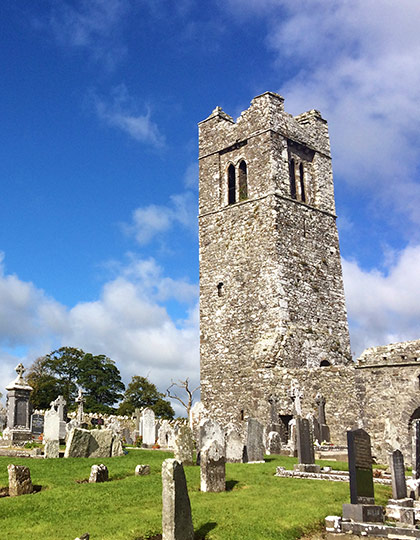
Cruise Excursions

8hrs | €650 + Booking Fees












